25 Pink Flowering Vines – Identification Guide and Pictures
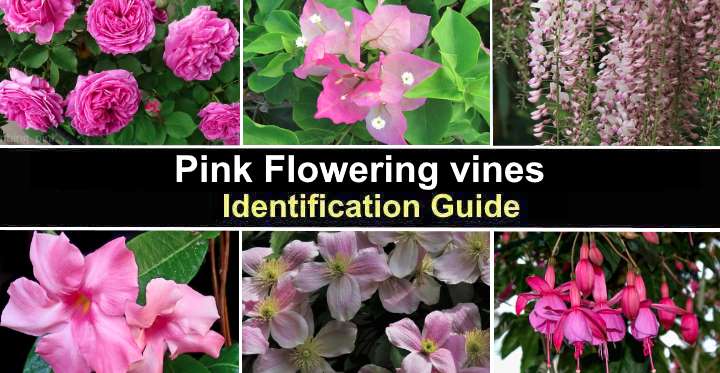
Pink-flowering vines infuse beautiful pink shades, beauty, elegance, and texture to garden landscapes. Climbing, scrambling, and trailing plants with pink blossoms create stunning floral displays, climbing trellises, fences, and garden structures. Many pink-flowering vining plants cascade over walls or grow as ground cover, enhancing outdoor spaces with romantic blooms.
Vines with pink flowers are a variety of species, each with unique characteristics and growth habits. Whether you’re looking for a vigorous climber like the pink jasmine or a more compact option like the pink clematis, there is a pink-flowering vine to suit every garden style and preference.
This article highlights different types of pink-flowering vines that can enhance the beauty of your front or backyard. Descriptions and pictures of climbing plants will help you identify the best vines to create a stunning visual display in your outdoor space.
What Are Vines with Pink Flowers?
Pink-flowering vines are vining plants with climbing, trailing, or scrambling growth habits. They have long stems with pink flowers that cling to structures using tendrils or suckers. Some pink vines like romantic wisteria, climbing roses, and bougainvillea have woody stems and require support to climb a fence, wall, or pergola.
Types of Pink Flowering Vines (with Pictures): Identification Guide
Let’s look in more detail at some of the most popular pink-flowering vines for your garden landscape.
Pink Japanese Wisteria (Wisteria floribunda ‘Rosea’)
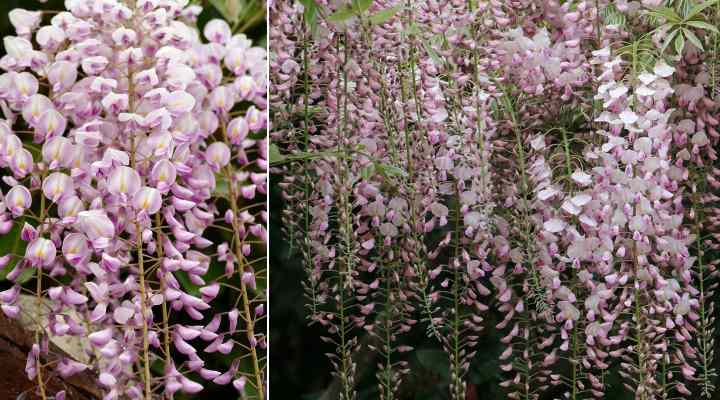
Pink Japanese wisteria is a stunning woody flowering vine with conical clusters of pink pea-like flowers dangling from woody stems. The pale-rose blooms grow in clusters 24” (60 cm) long, followed by long bean-like seed pods in late summer and fall. The vining plant also has dark green pinnate leaves, each with 15 lanceolate leaflets.
Pink Japanese wisteria is a vigorous grower that adds a touch of romantic elegance to garden landscapes when blooming in late spring and summer. This long-lived climber climbs up to 25 ft. (7.6 m) tall. It makes a great addition to sturdy support structures like a pergola, arbor, fence, or trellis.
Prune in late winter or early spring to remove dead or overcrowded branches. Trim long shoots to maintain the desired shape and size. Regularly remove any unwanted shoots to prevent excessive growth. In spring, apply a layer of compost around the base of the plant to enrich the soil and promote healthy growth.
- USDA Hardiness Zone: 5 to 9
- Light Exposure: Full sun or partial shade
- Flowering Season: Late spring and throughout summer
- Size: 10 to 25 ft. (3 – 7.6 m) tall and 4 to 8 ft. (1.2 – 2.4 m) wide
- Soil and Water Requirements: Moderately fertile, well-drained soil with medium moisture
Pink Flowering Bougainvillea (Bougainvillea ‘Imperial Delight’)

Pink-flowering bougainvillea is a beautiful, vibrant, flowering, evergreen thorny vining plant with beautiful pale pink flower-like bracts. Blooming throughout the year, bougainvillea has showy pink and white flowers, small lance-shaped leaves, sharp spines, and small fruits. The vigorous flowering vine grows up to 20 ft. (6 m) tall.
Pink flowering bougainvillea is a tropical climbing vine with pink flowers that can be trained to grow on a trellis, fence, or arbor. The pink flowers and dense foliage also perform as ground cover, wall-side borders, or in containers. Its drought and salt spray tolerance makes it ideal for growing in warm coastal locations.
Prune bougainvillea in early spring to shape the plant and remove any dead or diseased branches. Use pruning shears or gloves to protect your hands from thorns. Pinch back the tips of young shoots to encourage branching and more flowers.
- USDA Hardiness Zone: 9 to 11
- Light Exposure: Full sun
- Flowering Season: Spring through fall, but sometimes periodically throughout the year
- Size: 8 to 20 ft. (2.4 – 6 m) tall and 6 to 9 ft. (1.8 – 2.7 m) wide
- Soil and Water Requirements: Well-draining acidic soils
Pink Climbing Roses (Rosa)

Pink climbing roses are beautiful, romantic plants with showy, fragrant flowers in various shades—from soft pastel pink to vibrant hot pink. Climbing roses are known for their vigorous growth, stunning pink blooms, arching thorny canes, and dark green leaves. These versatile climbing plants clamber over trellises, fences, or walls.
Prune climbing roses in late winter or early spring before new growth begins. Remove dead or weak canes to improve air circulation. Cut back canes to a healthy bud, typically at a 45-degree angle. Train the canes to grow horizontally for more flowers. Each spring, add a layer of compost around the base of the rose plant to enhance soil fertility.
Here are four stunning varieties of climbing roses that have stunning showy pink flowers:
Rosa ‘New Dawn’: This repeat bloomer is one of the best climbing roses with pink flowers. It has pale pink large blooms and grows up to 15 ft. (4.5 m) tall and 10 ft. (3 m) wide.
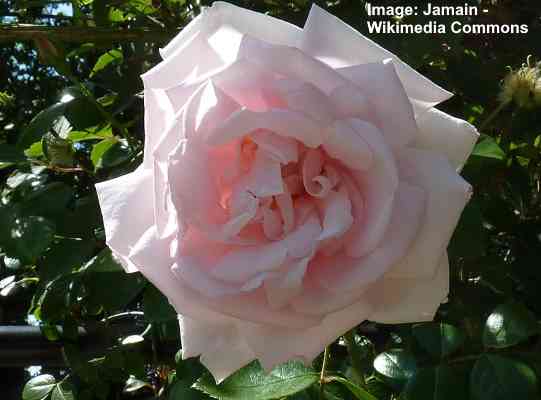
Rosa ‘New Dawn’
Rosa ‘The Generous Gardener’: This outstanding climbing rose has large, pale pink double blooms with heavenly scents. Ideal for arbors, fences, or walls, the free-blooming climber grows up to 10 ft. (3 m) tall and 4 ft. (1.2 m) wide.
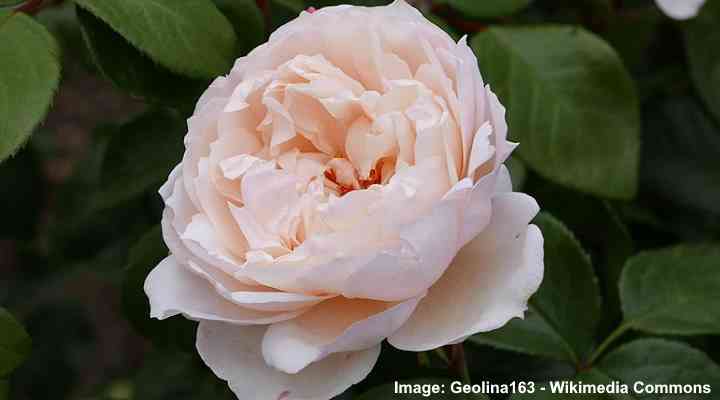
Rosa ‘The Generous Gardener’
Rosa ‘A Shropshire Lad’: This English rose climbing variety is a repeat bloomer with stunning flowers consisting of 100 peachy-pink petals. With some support, the climber can reach heights of 8 ft. (2.4 m) tall and 5 ft. (1.5 m) wide.
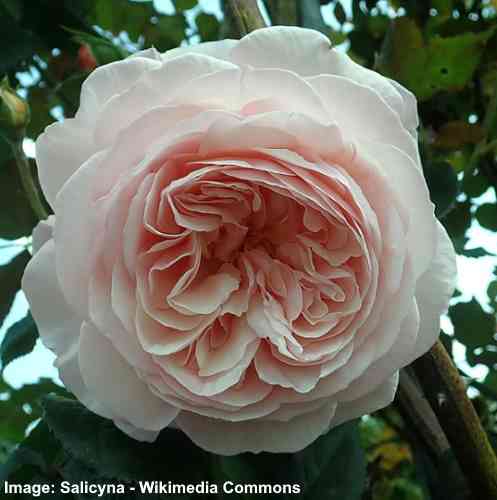
Rosa ‘A Shropshire Lad’
Rosa ‘Cecile Brunner’: This pink-flowering climbing rose has small blooms like hybrid tea roses. They are pale pink double flowers with fragrant scents. The masses of pink flowers bloom on thornless stems with a reddish tint. The pink climbing roses grow up to 20 ft. (6 m) tall and 6 ft. (1.8 m) wide.
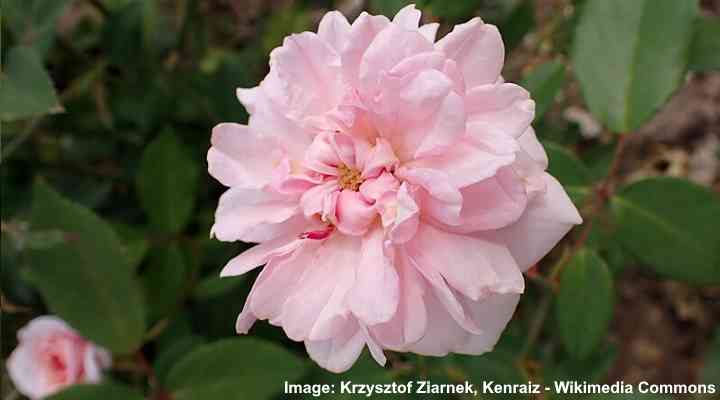
Rosa ‘Cecile Brunner’
Rosa ‘The Generous Gardener’ and Rosa ‘A Shropshire Lad’ are two stunning varieties of climbing roses that not only boast beautiful pink flowers but also fill your garden with a sweet and enchanting fragrance. These roses are known for their large, pale pink double blooms with heavenly scents. Ideal for arbors, fences, or walls, these free-blooming climbers grow up to 10 ft. (3 m) tall and are a delightful addition to any garden.
- USDA Hardiness Zone: 5 to 9
- Light Exposure: Full sun or partial shade
- Flowering Season: Spring and summer
- Size: Up to 25 ft. (7.6 m) tall
- Soil and Water Requirements: Humus-rich, fertile, well-drained soil that is constantly moist
Pink Clematis (Clematis)

Pink clematis is a group of attractive vining plants with large, showy pink flowers. Blooming from spring to fall, the elegant creeping vines generally have star-shaped flowers with pointed petals and lance-shaped leaves. Many of the pink-flowering vine varieties rebloom multiple times throughout the season and thrive in partial shade.
Pink clematis climbing vines are versatile plants for adding a splash of color to front or backyards. The attractive long-blooming flowers look beautiful, covering trellises, fences, or arbors. You can also grow them to vertical interest in your landscape.
Prune in late winter or early spring to remove dead or weak stems. Trim the vine to shape it and encourage new growth. Early-blooming varieties can be pruned after their first flush of flowers to promote a second bloom. Apply a compost mulch in early spring to provide nutrients and maintain soil moisture.
Here are four outstanding varieties of clematis with showy pink flowers:
Clematis ‘Pink Champagne’: This pink-flowering vine has masses of deep rose, rose-pink, or rose-purple star-shaped flowers. The spectacular blooms measure up to 8” (20 cm) across, blooming in late spring and then again in mid-summer to early fall. The early blooming clematis grows up to 8 ft. (2.4 m) long.
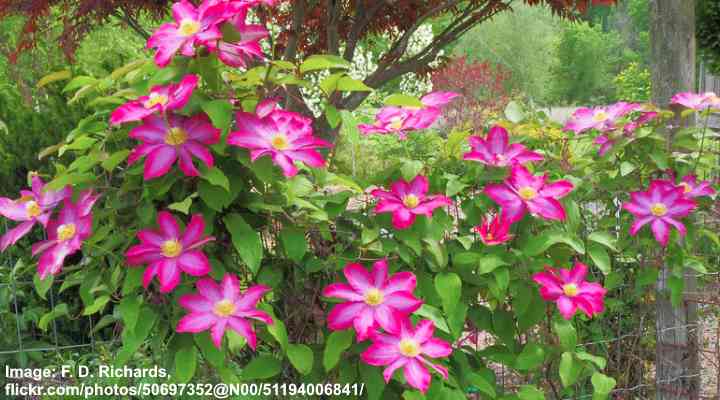
Clematis ‘Pink Champagne’
Clematis ‘Bees’ Jubilee’: The abundant pink flowers on the attractive scrambling plant are light pink petals with dark pink centers and prominent yellowish stamens. The large bi-colored pale pink and dark pink flowers measure 8” (20 cm) across, and they grow on vigorous stems up to 13 ft. (4 m) long.
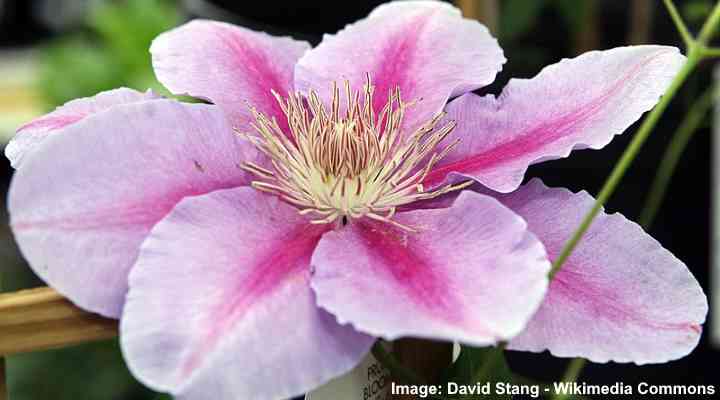
Clematis ‘Bees’ Jubilee’
Clematis ‘Carnaby’: This climbing, pink-flowering, easy-care clematis has large star-shaped flowers with deep pink petals and white margins. The large-flowered clematis vine blooms in spring through fall and grows up to 8 ft. (2.4 m) long.
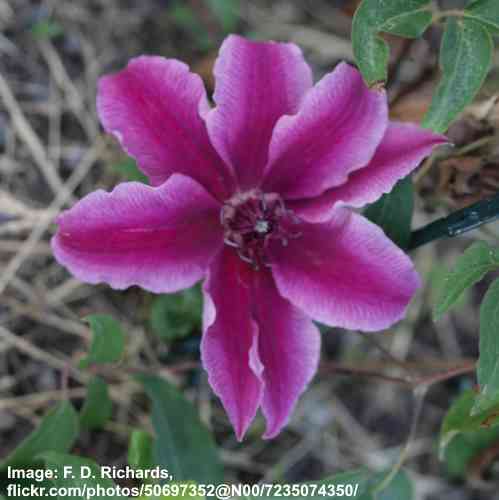
Clematis ‘Carnaby’
Clematis ‘Elizabeth’: This climbing clematis is known for its large pale pink, four-petalled flowers with a prominent tuft of yellow stamens in the center. The mauve-pink flowers emit floral fragrances, covering the vigorous vine in pink shades in spring and summer. This deciduous climbing plant grows up to 40 ft. (12 m) high.
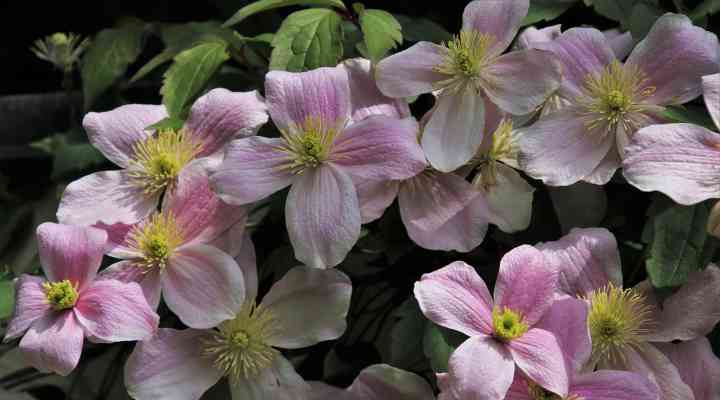
Clematis ‘Elizabeth’
- USDA Hardiness Zone: 4 to 9
- Light Exposure: Full sun to partial shade
- Flowering Season: Spring to early summer and then mid-summer to late fall
- Size: Up to 40 ft. (12 m) tall and 10 ft. (3 m) wide
- Soil and Water Requirements: Moist, well-drained soil
Pink Mandevilla (Mandevilla)

Pink mandevilla is an evergreen twining vine with stunning pink trumpet-shaped flowers. These large, showy blooms appear in late spring and persist until frost. The glossy green leaves provide a beautiful backdrop for the vibrant pink blooms, which emit a sweet fragrance. The tall climbing vine can reach heights of up to 15 ft. (4.5 m).
Pink Mandevilla thrives in tropical climates and is a popular pink-flowering vine in Florida and southern Texas. It’s tolerant of extreme heat and thrives in sunny landscapes growing over trellises, fences, or arbors. In temperate climates, you can grow pink mandevilla in a container as a patio plant and overwinter it indoors.
- USDA Hardiness Zone: 10 and 11
- Light Exposure: Full sun or partial shade
- Flowering Season: From late spring until late fall
- Size: 10 to 15 ft. (3 – 4.5 m) tall and up to 3 ft. (1 m) wide
- Soil and Water Requirements: Well-draining soil, but regular watering is necessary to keep the soil evenly moist
Brazilian Jasmine (Mandevilla sanderi)

Brazilian jasmine is a fast-growing, creeping vine with stunning deep pink trumpet-shaped flowers. The shrubby vine has lush foliage of leathery leaves growing on twining vines. These leaves contrast with the large pink-red tubular flowers that are 2.7” (7 cm) in diameter. The vine grows up to 15 ft. (4.5 m) tall.
Brazilian jasmine is a popular vigorous vine for trellises, fences, and arbors. Thriving in full sun, it quickly climbs and covers garden structures, decorating them with vibrant pink, red, and luscious green colors. The long-blooming flowers last from spring until fall.
Although this creeping vine has the common name Brazilian jasmine, it’s not a true type of jasmine vine in the genus Jasminum.
- USDA Hardiness Zone: 9 to 11
- Light Exposure: Full sun or partial shade
- Flowering Season: Spring until late fall
- Size: 10 to 15 ft. (3 to 4.5 m) tall and 3 to 6 ft. (1 to 1.8 m) wide
- Soil and Water Requirements: Most soil types with good drainage
Stephan Jasmine (Jasminum stephanense)

Stephan jasmine is a quick-growing deciduous vine prized for its fragrant pale-pink pinwheel flowers in June and July. This pink-flowering jasmine vine is identified by its compound, ovate leaves, light pink trumpet-shaped tubular flowers, and climbing stems up to 25 ft. (7.6 m) tall. The clusters of small pink flowers create a beautiful display.
This hardy, rapidly growing vine, thrives in full sun or partial shade. Its scrambling growth habit is ideal for creating a privacy screen, covering an unsightly garden structure, or growing over a fence.
Prune immediately after flowering to maintain a tidy appearance. Remove dead or straggly growth to encourage healthy new shoots. These vines bloom on old wood, so avoid heavy pruning in late winter or spring. In early spring, top-dress the soil with compost to provide essential nutrients.
- USDA Hardiness Zone: 7 to 9
- Light Exposure: Full sun or partial shade
- Flowering Season: Mid to late summer
- Size: 15 to 25 ft. (4.5 – 7.6 m) tall and 4 ft. (1.2 m) wide
- Soil and Water Requirements: Loose, humus-rich, well-drained soil that is evenly moist
Red Jasmine (Jasminum beesianum)

Red jasmine is a climbing vine known for its sweet-smelling dark pink to red funnel-shaped flowers. The tubular pink flowers bloom in clusters in late spring through summer, contrasting with the linear leaves. The deep pink flowers are followed by glossy black berries that persist into winter. The vine grows up to 20 ft. (6 m) tall.
Red Jasmine is a versatile scrambling shrubby vine. Its climbing habit makes it ideal for adding textures and deep pink shades to vertical spaces. You can also plant red jasmine along a trellis or fence or over an arbor.
Prune immediately after flowering to maintain a tidy appearance. Remove dead or straggly growth to encourage healthy new shoots. These vines bloom on old wood, so avoid heavy pruning in late winter or spring.
- USDA Hardiness Zone: 7 to 9
- Light Exposure: Full sun or partial shade
- Flowering Season: Summer
- Size: Up to 20 ft. (6 m) tall and 10 ft. (3 m) wide
- Soil and Water Requirements: Moderately fertile, well-drained soil
Pink Japanese Hydrangea Vine (Schizophragma hydrangeoides ‘Roseum’)
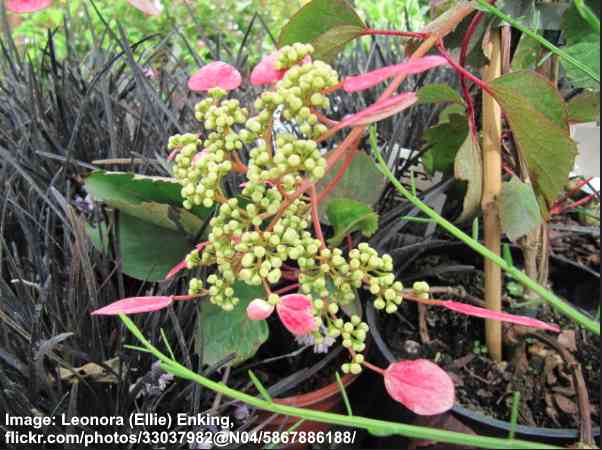
Pink-flowering Japanese hydrangea vine is a woody climber with rosy-pink and green lace-cap flowers. The unique vine flowers consist of a central cluster of tiny, fertile green flowers surrounded by larger, sterile, pink petal-like sepals. Dark green leaves surround the pinkish flowers, creating a stunning contrast.
The versatile pink-flowering climbing hydrangea is an excellent choice for vertical garden spaces. The self-clinging climber covers ugly garden structures, trellises, or walls. You can also let the slow-growing woody vine sprawl along the ground for ground cover with pink flowers.
- USDA Hardiness Zone: 5 to 9
- Light Exposure: Full sun to partial shade
- Flowering Season: Early summer and blooms for several weeks
- Size: Up to 30 ft. (9 m) tall and 15 ft. (4.5 m) wide
- Soil and Water Requirements: Well-draining soil
Pink Honeysuckle (Lonicera hispidula)

Pink honeysuckle is identified as a pink-flowering vine with showy clusters of tubular pink flowers. Blooming in late spring and early summer, the attractive, sweetly-scented flowers contrast nicely with the soft, fuzzy, dark green foliage. In late summer and fall, bright red ornamental berries grace the vining plant and attract wildlife.
Also called California honeysuckle, the low-maintenance climbing shrub is ideal for creating a shade or privacy screen by covering pergolas, trellises, or fences. It thrives just as well in full sun as in deep shade.
Honeysuckles, including pink honeysuckle, produce tubular flowers that are not only irresistible to hummingbirds but also provide a valuable nectar source for bees and butterflies.
- USDA Hardiness Zone: 7 to 9
- Light Exposure: Full sun, partial shade, or full shade
- Flowering Season: Late spring and early summer
- Size: Up to 20 ft. (6 m) tall and 10 ft. (3 m) wide
- Soil and Water Requirements: Well-drained soil
Coral Vine (Antigonon leptopus)

Coral vine is a fast-growing vine that produces clusters of vibrant coral-pink flowers growing on tendril stems. The long-blooming vine has summer flowers contrasting with arrow-shaped, wavy leaves. It grows up to 10 ft. (3 m) tall, and its stunning, colorful display brightens summer garden landscapes.
Coral vine is perfect for climbing over fences, trellises, or arbors. Alternatively, you can grow the heat-loving, drought-tolerant vine as fast-growing ground cover or in hanging baskets. Its heat and full sun tolerance make it an ideal vining plant for desert landscapes.
The vibrant coral-pink flowers of coral vine are a magnet for hummingbirds, but they are equally attractive to bees and butterflies.
- USDA Hardiness Zone: 9 to 11
- Light Exposure: Full sun
- Flowering Season: Early summer to fall, but all year in tropical climates
- Size: 8 to 10 ft. (2.4 – 3 m) tall and 3 to 6 ft. (0.9 – 1.8 m) wide
- Soil and Water Requirements: Well-drained soil, drought-tolerant once established
Pink Morning Glory (Ipomoea cordatotriloba)

Pink morning glory is identified by its spectacular funnel-shaped pink tubular flowers with darker throats. The twining vine blooms from summer through fall and has large heart-shaped leaves with three to five lobes. The vigorous perennial vine grows easily over a trellis, fence, arbor, or other garden structure.
Native to the southern United States, including Texas, pink morning glory can reach heights of up to 15 feet (4.5 m). This vine’s self-seeding nature allows it to grow easily. It’s also known by other names such as purple bindweed, tie vine, and coastal morning glory. Its sprawling growth habit makes it an excellent choice for pink-flowering ground cover.
Morning glory vines, including pink morning glory, feature tubular pink flowers that are a favorite of hummingbirds. Bees and butterflies also frequent these blooms, making them a valuable food source for a variety of pollinators.
- USDA Hardiness Zone: 8 to 10
- Light Exposure: Full sun
- Flowering Season: Summer through fall
- Size: 3 to 15 ft. (1 – 4.5 m) high
- Soil and Water Requirements: Well-draining soil, regular watering during the hottest months
Pink-Flowering Passion Vine (Passiflora x alato caerulea)

Pink-flowering passion vine is a stunning climbing plant with beautiful star-shaped pink and white flowers. These flowers not only captivate the eyes but also enchant the senses with their sweet fragrance. Other identifying features of the vine include its deeply lobed, glossy, dark green leaves and a ring of purple filaments in the large cup-shaped, starry flowers. The pink-flowering vine can reach heights of up to 20 ft. (6 m), making it a visually and aromatically delightful addition to your garden.
Landscaping ideas for pink-flowering passion vine include a trellis plant, wall or fence cover, or adding greenery, texture, and purple-pink colors to arbors or pergolas. When blooming all summer until fall, the pink vine creates a beautiful, eye-catching floral display.
Passionflower vines, such as the pink-flowering passion vine, boast intricate, nectar-filled flowers that attract hummingbirds. Bees and butterflies are often seen visiting these blooms, aiding in pollination and contributing to the garden’s biodiversity.
- USDA Hardiness Zone: 8 to 11
- Light Exposure: Full sun or partial shade
- Flowering Season: From early summer until early fall
- Size: 15 to 20 ft. (4.5 – 6 m) long
- Soil and Water Requirements: Loose, sandy, well-drained soil
Perennial Sweet Pea (Lathyrus latifolius)
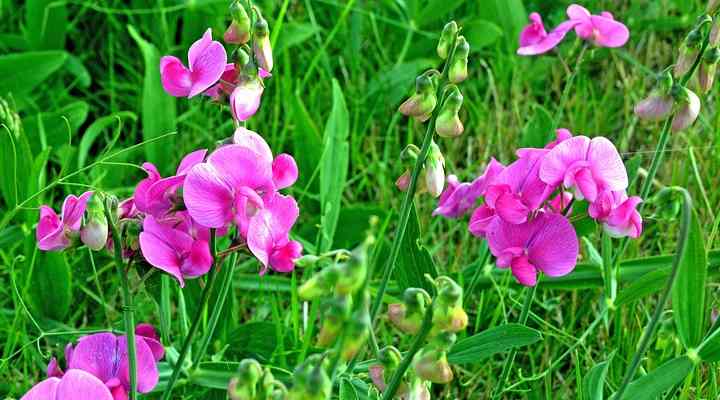
Perennial sweet pea is known for its vigorous growth, climbing habit, and clusters of vibrant rose pea-like blossoms. This pink-flowering vine has blue-green leaves growing on tendril-covered stems, allowing it to climb. The climbing vine grows up to 9 ft. (2.7 m) tall and blooms throughout the summer in most climates.
Unlike annual sweet peas, which need to be replanted yearly, perennial sweet peas are long-lived and will return year after year. The beautiful fragrant flowers are ideal for adding pink shades to support structures, trellises, or arbors. You can also let the vining pink plant sprawl as ground cover in full sun.
- USDA Hardiness Zone: 5 to 9
- Light Exposure: Full sun or partial shade
- Flowering Season: From early summer through fall
- Size: 6 to 9 ft. (1.8 – 2.7 m) tall a up to 6 ft. (1.8 m) wide
- Soil and Water Requirements: Fertile, well-drained soil with medium moisture
Climbing Snapdragon (Maurandya antirrhiniflora)

Climbing snapdragon is an attractive climbing or scrambling perennial vine with attractive tubular pink, red, or violet flowers. The attractive flowers contrast with the triangular, lobed leaves. The fast-growing vine quickly covers small trellises, fences, or walls, reaching up to 10 ft. (3 m) tall.
Also called roving sailor or little snapdragon vine, the climbing plant is a great pink-flowering vine for adding vertical interest to a front or backyard. You can also let the trailing stems grow as attractive ground cover.
- USDA Hardiness Zone: 9 to 11
- Light Exposure: Full sun or partial shade
- Flowering Season: Late spring to early fall
- Size: 5 to 10 ft. (1.5 – 3 m) tall and 3 ft. (1 m) wide
- Soil and Water Requirements: Well-drained, sandy soils
Bower Vine (Pandorea jasminoides)

Bower vine, also known as bower of beauty, is a vigorous evergreen woody vine with beautiful trumpet-shaped soft pink flowers. The eye-catching feature of the pink funnel flowers is the deep pink or red throat. The brightly-colored flowers contrast with the dark brown training stems and dark green, egg-shaped leaves.
Bower vine is a vigorous grower, making it ideal for screening, climbing over a wall or fence, or decorating trellises or pergolas. The vine is perfect for adding color and vertical interest to a front or backyard in tropical climates.
- USDA Hardiness Zone: 9 to 11
- Light Exposure: Full sun
- Flowering Season: Spring and summer
- Size: Up to 15 ft. (4.5 m) tall and 10 ft. (3 m) wide
- Soil and Water Requirements: Sandy or loamy, well-drained soil
Fuchsia ‘Lady Boothby’

Many fuchsia varieties are shrubby climbing vines with purple, pink and red flowers. Fuchsia is a vigorous climber that blooms from spring until the fall with a mass of dangling purple-pink or purple-red, bell-shaped flowers. The fuchsia vine leaves are dark green, ovate with serrated margins.
Fuchsia ‘Lady Boothby’ is a deciduous climbing hardy fuchsia with beautiful bicolored flowers in purple and deep pinkish-red that are known for attracting bees and butterflies. It has a vigorous upright columnar growth and will easily grow up a trellis, wall or fence with a support.
- USDA Hardiness Zone: 6 – 11
- Light Exposure: Full sun to partial shade
- Flowering Season: June to September
- Size: Up to 13 ft. (4 m) tall and 5 ft. (1.5 m) wide
- Soil and Water Requirements: Sandy or loamy, well-drained soil
Related articles:
